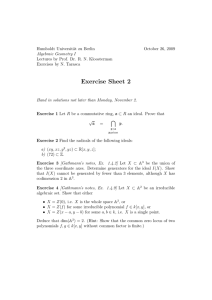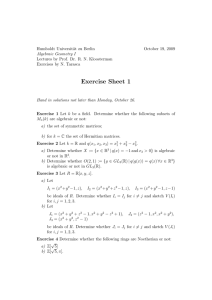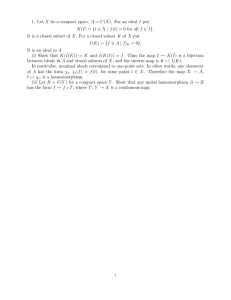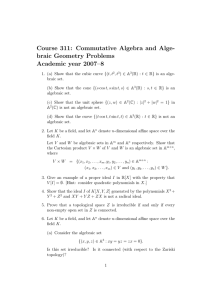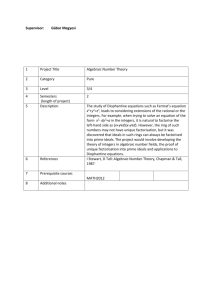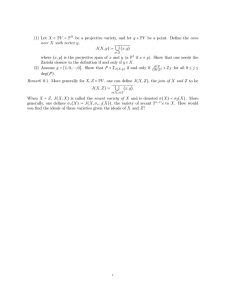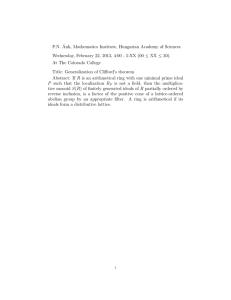Complex Algebraic Geometry: Varieties
advertisement
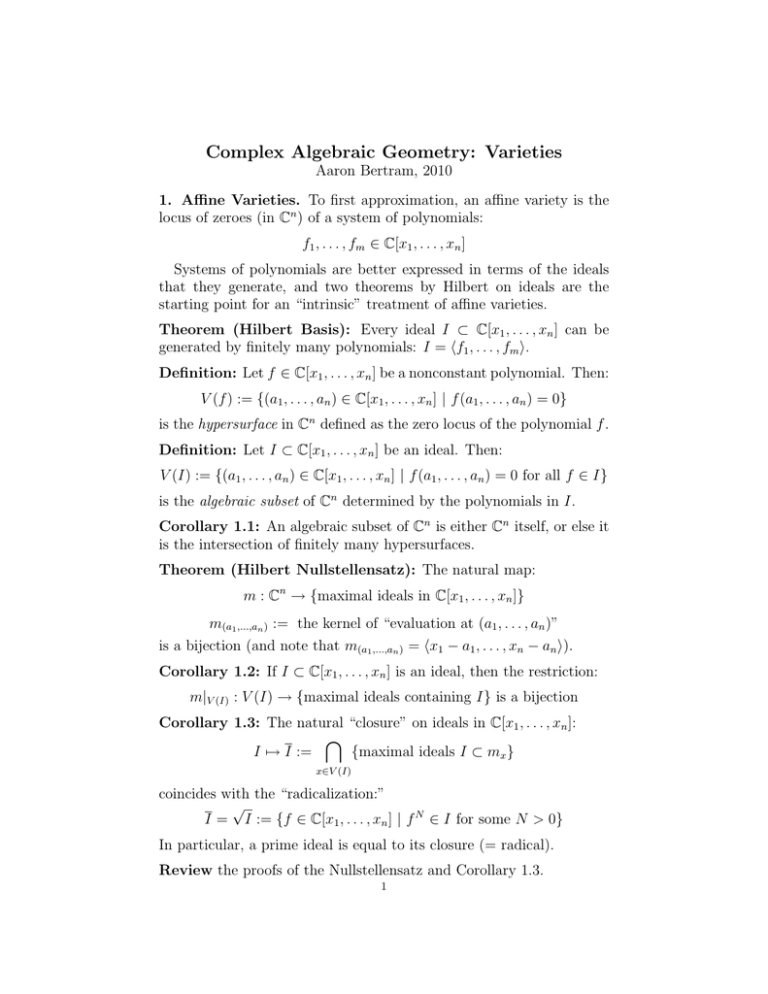
Complex Algebraic Geometry: Varieties
Aaron Bertram, 2010
1. Affine Varieties. To first approximation, an affine variety is the
locus of zeroes (in Cn ) of a system of polynomials:
f1 , . . . , fm ∈ C[x1 , . . . , xn ]
Systems of polynomials are better expressed in terms of the ideals
that they generate, and two theorems by Hilbert on ideals are the
starting point for an “intrinsic” treatment of affine varieties.
Theorem (Hilbert Basis): Every ideal I ⊂ C[x1 , . . . , xn ] can be
generated by finitely many polynomials: I = hf1 , . . . , fm i.
Definition: Let f ∈ C[x1 , . . . , xn ] be a nonconstant polynomial. Then:
V (f ) := {(a1 , . . . , an ) ∈ C[x1 , . . . , xn ] | f (a1 , . . . , an ) = 0}
is the hypersurface in Cn defined as the zero locus of the polynomial f .
Definition: Let I ⊂ C[x1 , . . . , xn ] be an ideal. Then:
V (I) := {(a1 , . . . , an ) ∈ C[x1 , . . . , xn ] | f (a1 , . . . , an ) = 0 for all f ∈ I}
is the algebraic subset of Cn determined by the polynomials in I.
Corollary 1.1: An algebraic subset of Cn is either Cn itself, or else it
is the intersection of finitely many hypersurfaces.
Theorem (Hilbert Nullstellensatz): The natural map:
m : Cn → {maximal ideals in C[x1 , . . . , xn ]}
m(a1 ,...,an ) := the kernel of “evaluation at (a1 , . . . , an )”
is a bijection (and note that m(a1 ,...,an ) = hx1 − a1 , . . . , xn − an i).
Corollary 1.2: If I ⊂ C[x1 , . . . , xn ] is an ideal, then the restriction:
m|V (I) : V (I) → {maximal ideals containing I} is a bijection
Corollary 1.3: The natural “closure” on ideals in C[x1 , . . . , xn ]:
\
I 7→ I :=
{maximal ideals I ⊂ mx }
x∈V (I)
coincides with the “radicalization:”
√
I = I := {f ∈ C[x1 , . . . , xn ] | f N ∈ I for some N > 0}
In particular, a prime ideal is equal to its closure (= radical).
Review the proofs of the Nullstellensatz and Corollary 1.3.
1
2
Definition: Let S ⊂ Cn be an arbitrary subset. Then:
\
I(S) :=
mx
x∈S
is the ideal in C[x1 , . . . , xn ] of polynomials that vanish on S.
Definition: An algebraic subset V (I) ⊂ Cn is irreducible if:
V = V1 ∪ V2 ⇒ V = V1 or V = V2
whenever V1 = V (I1 ) and V2 = V (I2 ) are algebraic sets.
Exercise 1.1: If V (I) is an irreducible algebraic set, then:
√
I = I(V (I))
is a prime ideal, and vice versa, V (P) ⊂ Cn is an irreducible algebraic
set whenever P ⊂ C[x1 , . . . , xn ] is a prime ideal.
Complex affine varieties are the irreducible algebraic sets in Cn
(for some n). It is crucial to have an “intrinsic” description of an affine
variety (i.e. without reference to the ambient Cn ), as a topological
space equipped with a sheaf of C-algebras. To this end, suppose:
X = V (P) ⊂ Cn
is an irreducible algebraic set. Then:
• The coordinate ring of X is C[X] := C[x1 , . . . , xn ]/P.
(C[X] is an integral domain that is finitely generated as a C-algebra.)
• The field of rational functions on X is the fraction field:
f
f
f0
0
0
C(X) :=
| f, g ∈ C[X] and g 6= 0 /
∼ 0 if f g = f g
g
g
g
(C(X) has finite transcendence degree as a field extension of C.)
• The points of X are in bijection with the maximal ideals in C[X]:
{x ∈ X} ↔ {maximal ideals mx ⊂ C[X]}
• The Zariski topology on X is generated by “open” sets of the form:
Uf := {x ∈ X |f 6∈ mx } ⊂ X for each f ∈ C[X]
(Uf is the complement (in X) of the hypersurface V (f ) ⊂ Cn )
• The germ of rational functions at each x ∈ X is:
f
Ox :=
| g 6∈ mx ⊂ C(X)
g
n
o
(Ox has unique maximal ideal m
e x := fg | f ∈ mx , g 6∈ mx ⊂ Ox .)
3
Note: I stopped writing the equivalence relation. So sue me.
• The regular functions on each open set U ⊂ X are:
\
OX (U ) :=
Ox ⊂ C(X)
x∈U
(OX (U ) is an integral domain containing C[X].)
Exercise 1.2. (a) Prove that the sets:
UI := {x ∈ X | I 6⊂ mx } determined by ideals I ⊂ C[X]
are always finite unions of the Uf ⊂ X, and that these sets are precisely
the open sets of the Zariski topology on X.
(b) Prove that
OX (Uf ) =
g
| n ≥ 0, g ∈ C[X]
fn
⊂ C(X)
In particular, conclude that OX (X) = C[X].
(c) Prove that each OX (U ) is finitely generated as a C-algebra.
(d) Show that the germ of rational functions Ox at x satisfies
[
Ox =
OX (U )
x∈U
and is not usually finitely generated as a C-algebra.
(e) Prove that
C(X) = ∪x∈X Ox = ∪U ⊂X OX (U )
Note also that U ⊂ V ⇒ OX (V ) ⊂ OX (U ).
Exercise/Example 1.3: Describe all the data above for X = C1 and
C2 . In particular, show that:
OC2 (C2 − {0}) = C[x1 , x2 ] = OC2 (C2 )
showing that shrinking an open set does not always increase the ring
of regular functions.
Next, prove that the Cartesian product of open sets in C1 is an open
set in C2 , but that, for example, the open subset:
Ux1 −x2 ⊂ C2 (the complement of the diagonal)
does not contain any (non-empty) product of open sets in C1 . Thus,
in particular, the Zariski topology on C2 is not the product topology
of the two Zariski topologies on C1 .
